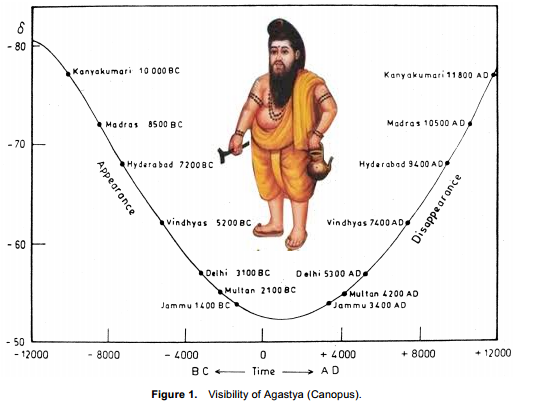Sage Agastya (star Canopus) and the Indian DNA pool
Sage Agastya is associated with the star Canopus. The heliacal rising of star Canopus was important for several ancient civilizations. Ancient Kings in India honored Agastya upon sighting the star Canopus. The famous astronomer Aryabhata discovered a formula for the time of heliacal rising of Agasya or star Canopus. However, the star Canopus has not been uniformly visible in the Indian subcontinent. Its visibility has varied over the millennia. Stories from the Purana refer to this variation as the “Southern sojourn of Agastya”. These stories provide an important clue about the synthesis of the gene pool of the Indian subcontinent.
Sapta Rishis and Agastya
Sapta Rishis are the seven great Rishis of the Vedic tradition. Sage Agastya is as important as the seven great Rishis. Hindu astronomy takes Ursa major group of stars to be a representation of the Sapta Rishis. Similarly, it takes the star Canopus to be Agastya. Firstly, Ursa Major is a northern constellation whereas Canopus belongs to a Southern constellation. Secondly, the heliacal rising of Canopus gives the impression that Agastya migrates Southwards and northwards. Thirdly, Purana writers convey this fact in form of stories. Consequently, Agastya or Agasthiyar is an important literary figure in the Vedic tradition as well as in the Tamil tradition.
Heliacal visibility of Canopus or Agastya

Canopus is a second brightest star in the night sky. However, it belongs to a constellation in the Southern hemisphere. Because of its location, the Greeks and the Romans could not observe it. However, it was well known in the Indian subcontinent. In fact, ancient astronomers noticed it becoming visible further north in the subcontinent, over the passage of centuries.
Agastya became visible (heliacally) north of Kanya Kumari only around 10,000 BCE. Secondly, those who resided south of the legendary Vindhya mountains alone noticed the heliacal rising of Agastya before 5700 BCE. Thirdly, Agastya or star Canopus was first sighted north of Delhi around the start of Kali Yuga Era (3100 BCE). However, people throughout the Indian subcontinent today can notice the rising of star Canopus.
The Agni Purana provides a list of rituals which the ancient Kings conducted during the course of a year. The heliacal sighing of Agastya is one of them. Consequently, we can conclude that the observation of helical rising of Canopus was in practice over the millennia in India. In another 5000 years from now, this star will once again be visible only to south of the Vindhyas. In one sense, the star Agastya migrates from the southern sky to the north and then reverses its direction! A story in the Padma Purana narrates the southern sojourn of Agasthya.

Aryabhata and heliacal rising of Canopus
Aryabhata gave a simple formula to predict the heliacal rising of Agastya. This fact affirms the importance attached to the heliacal rising of Canopus towards the beginning of the Common Era. Aryabhata’s formula is accurate for the west coast of Kerala along the meridian of Ujjain. K. Chandra Hari analyzes the formula in her paper (Āryabhata on the heliacal rise and set of canopus). The author uses the analysis to argue that Aryabhata lived in Kerala (in Chamravattam)
राशिचतुष्केण यदा स्वाक्षांश्युतेन भवति तुल्यो अर्कैः |
उदयो अगस्त्यस्य तदा चक्रार्धाच्छोधिते अस्तमयः ||
Aryabhata’s formula for the heliacal rising of Canopus
Genetic Melting Pot of the Indian subcontinent
The Ethnologists sampled DNA from a south Asian gene pool and published their conclusions in American Journal of Human Genetics. In brief, this study counters AIT (Aryan Invasion theory) which the twentieth century historians publicized widely. Secondly, the study suggests South Asian populace to be an admixture of two local ancestral gene pools. Besides, one of these two gene pools is associated with a westward migration from the Indian subcontinent. The westward gene likely played a big role in the Eurasian DNA pool.
Dispersal of Harappan genes
Anthropologists postulate that a sudden change in rain patterns forced the population of the Harappan civilization to disperse to the rest of India at some point in the past. This dispersal resulted in a more homogeneous genetic distribution around 2000 years ago. However, two millennia of genetic intermingling likely preceded this. All South Asians of today, (except those living in northeast Indian states) show genes of both North and South Indian ancestors. We can analyze the Southern Sojourn of Agastya (star Canopus) in the context of this genetic admixture. For first let us look at one myth about the caste system in India.
The caste of Rishis in the Veda
Indian caste system likely became rigid more recently. An important fact attests to this. Rishis of the lower castes and tribes (as accepted by the Indian Government surveys) contributed more than 60% of mantras in the Vedas. Rishi Vyasa, the son of a fisher women and Valmiki, previously a tribal robber are popular examples. An interesting story from the Puranas explains the overlap between the literary works in the Sanskrit language and the Tamil language.
Shiva dispatched Rishi Agastya according to a popular story to the southern tip of the Indian subcontinent. He wanted to prevent the northern part of the peninsula from sinking. A majority of sages were attending Shiva’s wedding there with Parvati in Kailash. Agastya or Agasthiyar is a leading figure in Tamil literature of lore. Agastya is an equally important literary figure in the Vedas. Some claim that the sage Agastya crossed the Vindhya mountains around 5200 BCE. This is because, anyone who went to the South of Vindhyas then would notice the heliacal rising of star Canopus. Canopus was not visible north of the Vindhyas in 5200 BCE.
Historians highlight the distinct features of southern languages which are not found in northern dialects. However, the oldest Tamil literature (3000 BCE) shares several important ideas with Vedic literature. The story of the southern sojourn of Agastya is an easy way to understand the intermingling of communities across the Indian subcontinent.